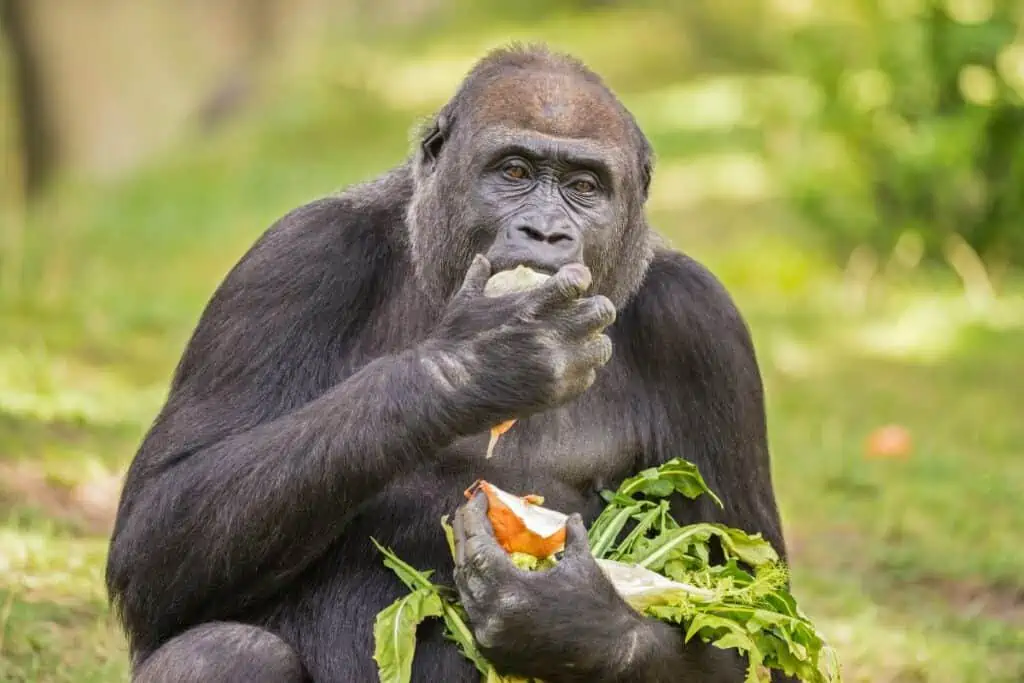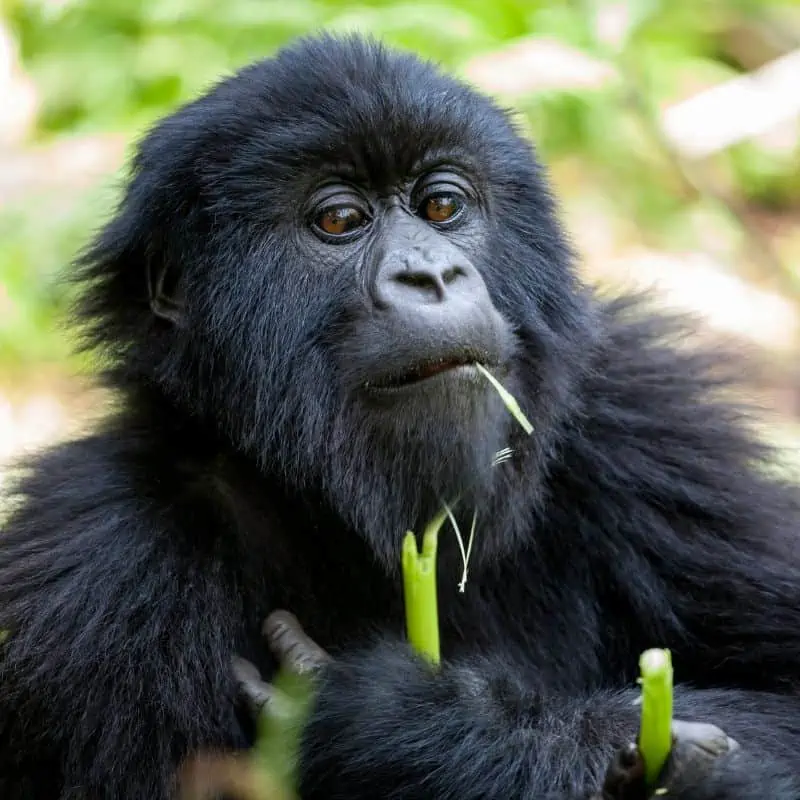Sharing up to 98% of their DNA with humans, gorillas are very humanlike in their behaviors and habits, so it makes sense that many would assume that gorillas are omnivorous, like we are. But this is not the case, so what do gorillas eat then?
Gorillas eat a largely vegetarian diet of plant leaves, stems, fruit, and roots. Depending on their natural habitat, some gorillas supplement their diet with grubs, insects, or even small lizards. Their diets mostly consist of plants, seeds, and pith and rarely any form of meat.
There are several factors to consider regarding a gorilla’s diet, so let’s break it down further.

What do gorillas eat?
Despite boasting large, muscular bodies that would lead most people to believe that gorillas eat meat, the truth is that gorillas are vegetarian – mostly.
They rely on the foliage around them to supply their nutrition, including the plants’ leaves, stems, bark, and roots, or the fruit, seeds, and nuts they produce.
That doesn’t mean gorillas are without protein entirely, with certain types of gorillas also indulging in grubs, insects, ants, termites, and even small reptiles.

What do different species of gorillas eat?
One of the giant apes, gorillas are fascinating animals that call central Africa home. There are a few different types of gorillas, and it’s important to distinguish between them because this impacts what comprises their diet.
As the largest primate on earth, gorillas have a lot of body to fill when they’re hungry and lots of muscle to nourish.
But to understand their diet better, it helps to know more about where they live.
The two different gorillas are Eastern and Western gorillas, and each of these has two other sub-species beneath it.
Eastern species are either Lowland or Mountain gorillas, while the Western types are known as Western Lowland or Cross River gorillas.
Mountain gorillas survive in much higher altitudes up in the mountains, as their name suggests. They can survive freezing temperatures, unlike Lowland gorillas living in temperate rainforests.
Naturally, the differences in habitat also mean the foliage, substrate, and available foods are very different – so while gorillas are primarily herbivorous, some species differ a little.
A predominantly vegetarian diet forms the foundation for all gorilla meals, which include stems, shoots, fruits, and seeds. Some species have been known to eat insects and other invertebrates.
It’s important to know that a largely vegetarian diet has a much lower nutritional quality than meat-based diets, which means gorillas must consume a large quantity of food to fuel their large, hulking bodies.
Let’s break their diet down into the various subspecies to gain a better understanding of what it is that gorillas eat.
Western Lowland Gorillas
Living high up in the mountains, the Western Lowland gorilla’s diet comprises about 67% fruit, 17% leaves, seeds, stems, and shoots, and the remaining 3% is comprised of termites and caterpillars, which abound in the mountainous regions.
Most of the foods they consume are high in fiber, and a lot of their time is spent foraging for the foods they like.
They also put their highly intelligent brains to good use when they want to get succulent insect snacks.
It’s interesting to see them break open termite nests to find the most succulent of the termites to snack on.
Western Cross River Gorillas
These are the rarest gorilla species, so there hasn’t been quite as much knowledge about them as there is for the other types.
Still, studies of their fecal matter and observation show that they eat mostly fruit and plants.
They have been observed traveling many miles and large distances to find their favorite types of fruits and eat a ginger plant native to their habitat. They peel the stem and eat the soft center.
Cross River gorillas eat liana vines, tree bark, leaves, nuts, and berries. Most of these also contain sufficient moisture content that ensures gorillas don’t dehydrate.
They also eat some insects and lizards, but not quite as often.
Eastern Lowland Gorillas
Much like their Western Lowland counterparts, these gorillas consume large quantities of plants, stems, bulbs, shoots, leaves, and any fruits, berries, or vegetables they can get their hands on.
The main difference between these gorillas and their Western Lowland counterparts is that their menu includes a wider variety of available plant species to consume.
They have often been seen in the trees, high up, pulling bark off and stripping leaves.
This also means they can eat peacefully without being concerned about potential predators.
Eastern Mountain Gorillas
Possibly the most varied in meals, the Eastern Mountain gorillas (also known as the Congo Mountain Gorilla) have a much larger variety of plant species on the menu.
But since fruits are scarce at high altitudes, fewer of these make it onto their menu.
About 86% of their diet consists of leaves and stems, shoots, and other plant matter, while 7% are roots, 3% is made up of flowers, 2% of the occasional fruit, and – interestingly – the remaining 2% comprises snails, ants, and other grubs.

Interesting facts about what gorillas eat
Male gorillas eat up to 40 pounds of food per day. They have to eat enough to provide the energy for their muscular bodies to remain strong, which means a lot of salad since their meals are devoid of meat proteins.
Since gorillas consume so much vegetation, consisting of high-moisture leaves, stems, and fruits, they don’t drink as much water as other animals.
They do sip from pools occasionally and take in more moisture by ingesting vegetation with dew on it.
Gorillas have also been seen dipping their hands in water and sucking the moisture from the hairs on the back, but they generally stay away from bodies of water as they can’t swim.
Foraging seems like a peaceful and quiet activity. Still, the foods gorillas like to eat often require them to pull bark off, rip apart vegetation, or pull down branches – luckily, gorillas are powerful and have a 1300 psi bite force, making this an easy task.
Pith, the spongy, tender inner bits of some plants and fruits, is a particular favorite among gorillas.
Despite their incredible size, they have nimble fingers and dexterous lips that help them get to the delicate inner parts that they love to eat.
Naturally, baby gorillas have a slightly different diet. For starters, babies suckle and subsist on their mother’s milk for around two to three years before switching to the same food the older gorillas eat.
Younger gorillas will also eat some insects, but not in large quantities.
Lastly, it’s worth remembering that a gorilla’s diet will change a little from season to season, depending on what is available.
Final thoughts on what gorillas eat
While gorillas mostly share the same essential diet, including leaves, bark, stems, and fruit, some sub-species add grubs, insects, and ants to the mix.
For the most part, the vegetarian diet is sufficient to provide nutrition, but large quantities must be consumed.
Depending on their habitat, gorillas will also eat fruits, berries, seeds, and roots when available.
